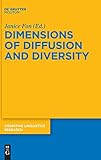Dimensions of Diffusion and Diversity / ed. by Janice Fon.
Material type: TextSeries: Cognitive Linguistics Research [CLR] ; 63Publisher: Berlin ; Boston : De Gruyter Mouton, [2019]Copyright date: ©2019Description: 1 online resource (VI, 279 p.)Content type:
TextSeries: Cognitive Linguistics Research [CLR] ; 63Publisher: Berlin ; Boston : De Gruyter Mouton, [2019]Copyright date: ©2019Description: 1 online resource (VI, 279 p.)Content type: - 9783110608120
- 9783110608236
- 9783110610895
- online - DeGruyter
- Issued also in print.
| Item type | Current library | Call number | URL | Status | Notes | Barcode | |
|---|---|---|---|---|---|---|---|
 eBook
eBook
|
Biblioteca "Angelicum" Pont. Univ. S.Tommaso d'Aquino Nuvola online | online - DeGruyter (Browse shelf(Opens below)) | Online access | Not for loan (Accesso limitato) | Accesso per gli utenti autorizzati / Access for authorized users | (dgr)9783110610895 |
Frontmatter -- Contents -- Introduction -- Part I: Language variation from a linguistic perspective -- 1. Characteristics of lexical conventionalization in Chinese -- 2. Typological study on expressions of possibility and their related meanings in English, Chinese and Japanese – How modality and voice intersect -- 3. Rhythmic synchrony in conversation -- Part II: Language variation from a nonlinguistic perspective -- A Variation in speakers’ cognitive capability -- 1. Botany meets lexicology: The relationship between experiential salience and lexical diversity -- 2. The price of knowledge: A bilingual paired associate learning study -- 3. The use of cognitive state verbs in narratives of school-age Cantonese-speaking children with and without language impairment -- B. Variation in the general context -- 1. Lexical variation of ideophones in Chinese classics: Their implications in embodiment and migration -- 2. A case study of accent shift in the Ryukyuan languages -- 3. Textual patterns of modern western paintings: A cognitive multimodal exploration -- Index
restricted access online access with authorization star
http://purl.org/coar/access_right/c_16ec
Variation is the norm in language. It is the universal trait that has never been embarrassed by counterexamples. As language is a joint product of human cognition and human society, the dimensions underlying language variation could potentially reveal the complexity of the human mind and defines us of what we are as cognitive and social beings, be it Austrians speaking German, or Nepalis speaking Dumi. This volume includes eight papers highlighting three dimensions underlying language variation. The linguistic dimension explores how language changes across the physical time span and across linguistic breadth. The cognitive dimension examines how the human mind handles experiential frequency and life experiences, and how it copes with suboptimal processing faculties. Finally, the contextual dimension focuses on how language interacts with its ambiance, either in the form of geographical surroundings, or in the form of artistic styles. The uniqueness of this volume lies not only in its wide range of dimensions investigated, but also in its broad spectrum of languages covered. This enables us to form a fuller understanding of how language evolves and interacts with human cognition.
Issued also in print.
Mode of access: Internet via World Wide Web.
In English.
Description based on online resource; title from PDF title page (publisher's Web site, viewed 25. Jun 2024)


